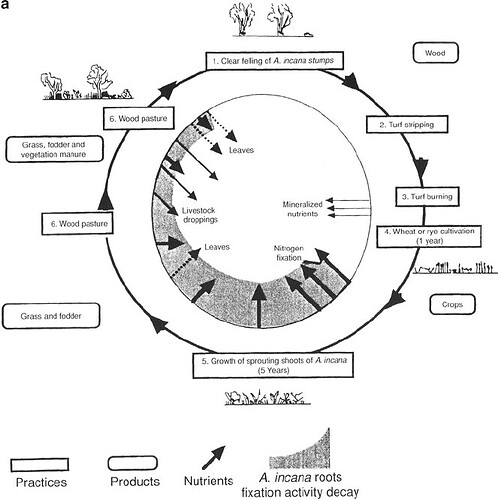I’ve been reading “Coppice Agroforestry” recently (great book btw!) and intrigued by a section on “Alnoculture”, an old European alder coppice agroforestry system, not in use any longer. I found this diagram to explain it a bit, but essentially alder is grown on a ~10 year rotation. After cutting, the turfs are lifted and burned then rye/wheat is grown for a few years until the alder shades it out (and tree hay harvested). Then it’s left until the regrowth is big enough and livestock is introduced to graze the coppice until ready to harvest then the cycle starts again. The use of alder specifically is for nitrogen fixing, which apparently is highest in the early years of regrowth so coppicing maximises available nitrogen in the soils.
Image from (abd further reading): https://www.researchgate.net/figure/Alnocolture-a-traditional-agroforestry-system-involving-Alnus-incana-formerly-used-in_fig3_278709228
1 Like
Interesting. In the back of my mind I recall reading about Alnus Incanca suckering more than other alders. I wonder if it suckers more in response to being coppiced. I assume the wood was used for fuel, but I wonder if it was also used for tree hay.
1 Like
Having read up a bit further (hard to find proper info) it seems that the end product was firewood / charcoal but the stems were thinned along the way and tree hay was a big part of the harvest in earlier years. The choice of Alder Incana seems strange as it’s also not supposed to be the best at coppicing. They obviously knew how to make it work.
It’s mentioned in the book that there is only basic info now available so the details (spacing, products, other species) aren’t really known.
It’s made me want to experiment interplanting alder coppice here and stacking functions a bit in our firewood coppice. I’ll try aramanth, quinoa, bere, and squash this year - it’s a long shot though!
1 Like
